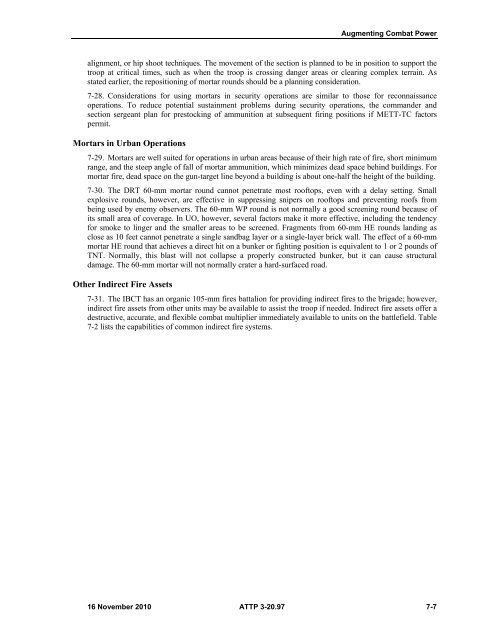Dismounted Reconnaissance Troop - Army Electronic Publications ...
Dismounted Reconnaissance Troop - Army Electronic Publications ...
Dismounted Reconnaissance Troop - Army Electronic Publications ...
You also want an ePaper? Increase the reach of your titles
YUMPU automatically turns print PDFs into web optimized ePapers that Google loves.
Augmenting Combat Power<br />
alignment, or hip shoot techniques. The movement of the section is planned to be in position to support the<br />
troop at critical times, such as when the troop is crossing danger areas or clearing complex terrain. As<br />
stated earlier, the repositioning of mortar rounds should be a planning consideration.<br />
7-28. Considerations for using mortars in security operations are similar to those for reconnaissance<br />
operations. To reduce potential sustainment problems during security operations, the commander and<br />
section sergeant plan for prestocking of ammunition at subsequent firing positions if METT-TC factors<br />
permit.<br />
Mortars in Urban Operations<br />
7-29. Mortars are well suited for operations in urban areas because of their high rate of fire, short minimum<br />
range, and the steep angle of fall of mortar ammunition, which minimizes dead space behind buildings. For<br />
mortar fire, dead space on the gun-target line beyond a building is about one-half the height of the building.<br />
7-30. The DRT 60-mm mortar round cannot penetrate most rooftops, even with a delay setting. Small<br />
explosive rounds, however, are effective in suppressing snipers on rooftops and preventing roofs from<br />
being used by enemy observers. The 60-mm WP round is not normally a good screening round because of<br />
its small area of coverage. In UO, however, several factors make it more effective, including the tendency<br />
for smoke to linger and the smaller areas to be screened. Fragments from 60-mm HE rounds landing as<br />
close as 10 feet cannot penetrate a single sandbag layer or a single-layer brick wall. The effect of a 60-mm<br />
mortar HE round that achieves a direct hit on a bunker or fighting position is equivalent to 1 or 2 pounds of<br />
TNT. Normally, this blast will not collapse a properly constructed bunker, but it can cause structural<br />
damage. The 60-mm mortar will not normally crater a hard-surfaced road.<br />
Other Indirect Fire Assets<br />
7-31. The IBCT has an organic 105-mm fires battalion for providing indirect fires to the brigade; however,<br />
indirect fire assets from other units may be available to assist the troop if needed. Indirect fire assets offer a<br />
destructive, accurate, and flexible combat multiplier immediately available to units on the battlefield. Table<br />
7-2 lists the capabilities of common indirect fire systems.<br />
16 November 2010 ATTP 3-20.97 7-7

















